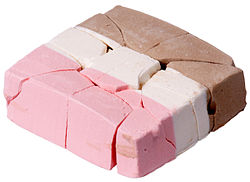Freeze-dried ice cream
 Freeze-dried Neapolitan ice cream | |
| Type | Ice cream |
|---|---|
| Created by | Whirlpool Corporation |
Freeze-dried ice cream is ice cream that has had most of the water removed from it by a freeze-drying process, sealed in a pouch, and requires no refrigeration.
It is also known as astronaut ice cream or space ice cream, typically a slab of ready-to-eat dehydrated ice cream. Compared to regular ice cream, it can be kept at room temperature without melting and is more brittle and rigid but still soft when bitten into. It was developed by Whirlpool Corporation under contract to NASA for the Apollo missions.[1] [2] Freeze-dried foods were developed so that foods could be sent on long-duration spaceflights, as to the Moon, and to reduce the weight of the water and oxygen normally found in food.[1]
Freeze drying (or lyophilization) removes water from the ice cream by lowering the air pressure to a point where ice sublimes from a solid to a gas. The ice cream is placed in a vacuum chamber and frozen until the water crystallizes. The air pressure is lowered, creating a partial vacuum, forcing air out of the chamber; next heat is applied, sublimating the ice; finally a freezing coil traps the vaporized water. This process continues for hours, resulting in a freeze-dried ice cream slice.
Freeze-dried ice cream is sold by mail order and is common in science museums and NASA visitor center gift shops, sometimes accompanied by other freeze-dried foods.
Space use
Apollo 7 in 1968 was the first and only NASA mission on which freeze-dried ice cream flew in space. It was developed by U.S. Army Natick Laboratories, consisting of "coconut fat, milk solids, and sugar. The ice cream was homogenized, frozen, then freeze-dried, ground and compressed into cubes under high pressure. The cubes were then coated with an edible gelatin coating to prevent crumbs".[3] This was the ice cream flown on Apollo 7, which can differ from modern space ice cream.[3] It was found to be impractical for space flight because of the tendency to crumble and create crumbs which can be dangerous to humans and equipment in a microgravity environment.[4][5] Despite the modern images of space walking astronauts in shuttle era space suits, freeze dried ice cream was not included on any subsequent Apollo, Skylab, shuttle or International Space Station missions.[6] According to one NASA food scientist, although freeze-dried ice cream was developed on request, "it wasn't that popular."[7]
Traditional ice cream in space
By 1972, astronauts also ate classic ice cream on the Skylab space station and regular ice cream has also been eaten on the International Space Station.[8] Skylab had a refrigerator that was used for regular ice cream,[9] and occasionally Space Shuttle and International Space Station astronauts have taken regular ice cream into space.[10]
See also
References
- ^ a b "Space Food" (PDF). NASA. Retrieved 2007-06-07. The license is now not held by Action Products International, Inc.
- ^ Astronaut Ice Cream
- ^ a b NASA FTCSC Kid's Page Terrestrial Trivia (answer section)
- ^ "Space Food Hall of Fame". NASA.
- ^ Thompson, Gregory L. Vogt ; illustrations by Colin W. (2010). Is there life on other planets? and other questions about space. Minneapolis, MN: Lerner Publications. ISBN 0-7613-5945-1.
{{cite book}}: CS1 maint: multiple names: authors list (link) - ^ "NASA Spinoff homepage". NASA. Retrieved 2007-06-07.
- ^ "A Holiday Dinner in Space". NASA. December 15, 2005. Retrieved 2009-08-13.
- ^ Surprise! Astronauts Eat in orbit
- ^ "History of Food in Space". NASA. Archived from the original on 2007-05-26. Retrieved 2007-06-07.
- ^ "Orbital Ice Cream, Atlantis' ISS Surprise". LiveScience.com. 2006-09-16. Retrieved 2007-06-07.
